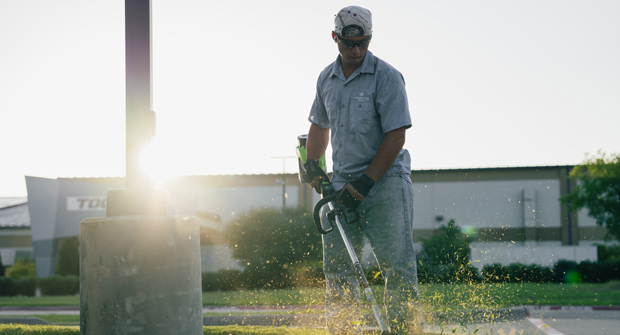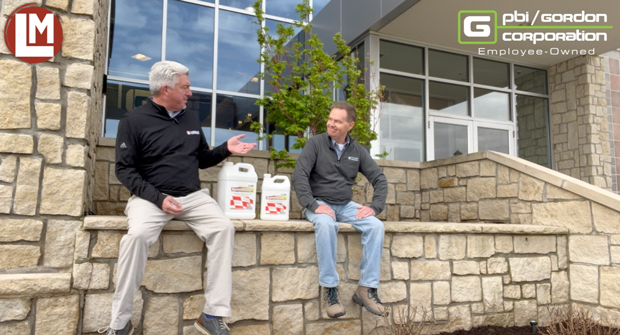[SPONSORED CONTENT] Editor-in-Chief Scott Hollister visits the PBI-Gordon lab to meet with Dale Sanson, Ph.D., senior director of formulation development in compliance chemistry, to learn about Arkon™ Herbicide Liquid.
This video is sponsored content by PBI-Gordon.
Transcription:
SH: Scott Hollister
DS: Dr. Dale Sanson
SH: Hey everybody. It’s Scott Hollister with Landscape Management magazine, and we are in downtown Kansas City, Miss., at the formulation labs for PBI-Gordon with Dr. Dale Sanson. Dr Dale is the senior director of formulation development and compliance chemistry, that’s a little bit of a mouthful. Yeah, I’m getting it down, though, and we’re excited to be here and learn a little bit more about what you do here in the lab. Dr. Dale, and this great product here that I think a lot of our lawn care applicators who are watching will be familiar with, and that is Arkon™. To start off, we have an example of the formulation here. What is Arkon™? What would most lawn care applicators know about the product?
DS: Arkon™ is an exception to the traditional way of treating sedges, kyllinga, which is traditionally done with a classic chemistry called Sulfonylurea. The Sulfonylureas have been great, tried and true for years. They do have inherent weakness. Once they’re added into the spray tank, the active ingredient begins to decompose, as opposed to Arkon™ the active ingredient Pyrimisulfan has very good long term chemical and physical stability in the spray tank. I’ve got a sample of it here. In the formulation world, this is called a viewing tube. You can see how well it flows, not viscous, which means it’s going to tank mix or add to the tank, very easy. There is a penetrant built into it. There’s no need to use an adjuvant. There’s also what’s called a sequestering agent. That’s very important whenever you’re mixing into a spray tank that you may have hard water, such as iron, calcium, magnesium, dissolved solids, the sequestering agent goes out, grabs those components, renders them neutral, allows for the chemistry to do what it was designed to do, in this case, ultimately control those problematic weeds.
SH: And this product is good for lawn care applicators in both the southern and northern parts of the country? And kind of run through some of the flexibility that offers them and some of the main targets, the weeds that are going to be seeing this.
DS: Great deal of flexibility. In fact, I picked out some of the key formulas in our portfolio, or products rather, in our portfolio that allow the versatility for the end user to be able to dial in the Arkon™ to control the target weeds that these others may not have on the label. Arkon™ was developed specifically for control of kyllinga, perennial, annual, yellow, you name it, any type of a nutsedge, also kyllinga. The good thing about Arkon™ is it actually, the active ingredient trans locates down to the tuber, and eliminates the tubers, so you don’t get that regrowth that you traditionally see with some of the products on the market. Some of them may go in, they control the sedge, but they’re typically just burning off the top, but you still have that net lit down the ground that it’s going to come back. This case, it does not when I’m talking about the versatility of adding and the longevity and spray tank. This morning, what I did is I actually took our Avenue South and one of our fertilizers and did simulated spray tanks, put these together in the right ratio, as it appears on the label, one to show the fact that it’s still uniform after four hours of sitting. So you can be assured, using Arkon™, has good tank mix compatibility. In fact, I have a demo here. On the label of any label you see that they suggest a jar test. A jar test is a way of putting components together that you may want to put in a spray tank, make sure that there’s no physical or chemical incompatibility. So as that’s mixing, I’m going to let that come up to speed. I want to talk about the “wales” mixing order. When you look at “wales”, W, A, L, E, S, it’s a step wise progression of adding tank mix partners to hopefully increase your success of application. So if you Google “wales”, you’re going to find all the details of that from a university extension, or a lot of large companies have their own version. So that’s mixing together. I’m going to mix these together. I’m going to mix some Arkon™ in with our Avenue South. And as you can see, this has been sitting for four hours. Still looks good, but I’m gonna put together in real time. So according to “wales” mixing order, I’m gonna add our Arkon™ first. And you can see how easy that goes into the spray tank. That’s what we call “bloom” in the formulation world. That means it’s going together very well. As that’s getting mixed, what I want to do is to touch on your SDS. When you’re mixing multiple components into a spray tank, I strongly advise going to section nine of your SDS, Safety Data Sheet. There’s an area that has pH. Look at that pH. And if you’re adding multiple spray tank partners together, and that pH is beyond two between the two, you may want to be advised not to do that. So, good piece of documentation. Okay, now we’ve let this go for about a minute. Looks very uniform. I’m going to add it together with our Avenue South. So this is enhancing the attributes of Avenue South by picking up those sedges, kyllinga from the Arkon™. Going to mix that together, and I can rest assure it’s going to go in just as well as the Arkon™. Isn’t that pretty. Look at that. Nice bloom. And then you can increase your agitation a little bit if you want to, go grab some coffee, get ready for your day, and you’ve got a successful tank mix partner there.
SH: Yeah. Just amazing flexibility. What do you hear from lawn care applicators when they talk about this product? Is that flexibility the first thing that comes to the forefront?
DS: Flexibility and ultimately, the fact that there was no regrowth. We introduced this last year, very successful launch. The feedback we got back was the fact that, hey, we didn’t burn off the top. We actually took care of the problem. It’s that translocation, it’s that penetrant technology. It’s all the attributes of that formula that make it a winner compared to some of the other sedge products on the market.
SH: Well, very instructive, Dr. Dale. I appreciate your time. Some amazing tips and tricks, and the visual aid is helpful for someone like myself, so really, really appreciate it. Dr. Dale, thanks for your time today. Scott Hollister, with Landscape Management, thanks for watching on Landscape Management TV.


